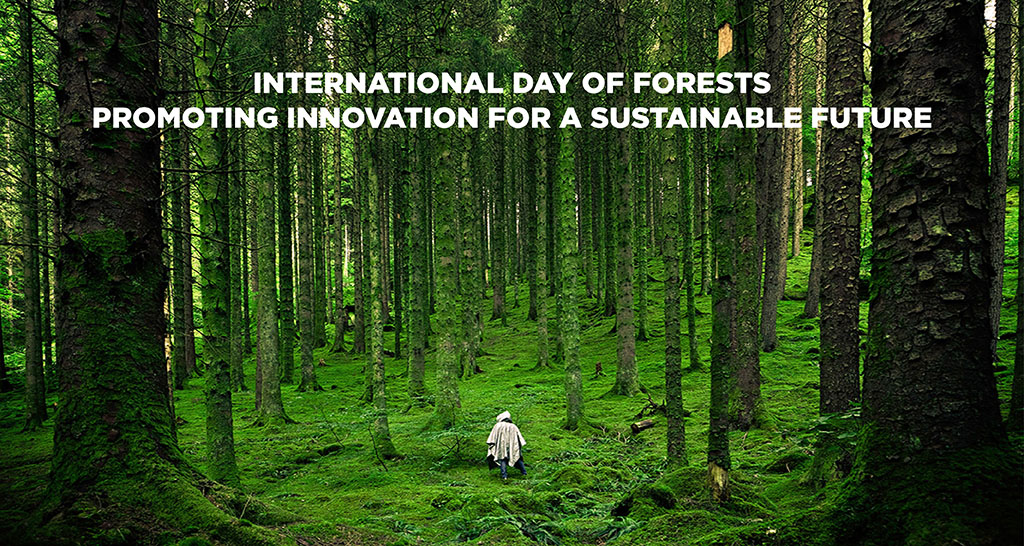The International Day of Forests, celebrated annually on March 21st, is a global platform for raising awareness of forests’ importance and promoting action for their conservation and sustainable management. Established by the United Nations General Assembly in 2012, the International Day of Forests highlights forests’ critical role in supporting biodiversity, combating climate change, and fostering sustainable development.
Forests, commonly known as the lungs of the planet, play a crucial role in maintaining the delicate balance of Earth’s ecosystems. These vast areas of trees act as natural carbon absorbers by absorbing carbon dioxide and releasing oxygen, thus helping to lessen the impacts of climate change. Beyond their environmental importance, forests are habitats for many plant and animal species, provide livelihoods for millions of people worldwide, and offer many recreational opportunities for society. However, despite their vast value, forests face new and severe dangers from deforestation, damage to habitat degradation, and uncontrollable fires. In response to these challenges, the global community increasingly uses innovation and technology as powerful forest conservation and sustainability tools.
The Critical Role Of Forests In The World
Forests aren’t just groups of trees; they are complex ecosystems full of life and connected ecological processes. From the tall roofs of tropical rainforests to the vast expansion of boreal forests, these environments hold a remarkable variety of biodiversity. They provide habitat for countless species of plants, animals, insects, and microorganisms, many of which are found nowhere else on Earth. Additionally, forests are crucial for the water cycle, controlling rainfall patterns, stopping soil erosion, and maintaining the quality of freshwater sources. They also play a vital part in climate regulation, absorbing carbon dioxide from the atmosphere and helping to keep global temperatures steady.
In addition to their ecological importance, forests are essential for human well-being and sustainable development. They provide invaluable ecosystem services, such as carbon absorption, air and water purification, and soil fertility. Forests also support local economies by producing timber, other forest products, nature tourism, and recreational activities. Furthermore, forests are essential for native and local communities, serving as food, medicine, and cultural heritage sources. Therefore, forest preservation and sustainable management are crucial for environmental sustainability and human livelihoods.
Challenges Facing Global Forests
Despite the huge importance of forests, they face increasing pressure from various dangers. The main one is deforestation, which means permanently converting forested land for agricultural, industrial, or urban purposes. According to the United Nation Food and Agriculture Organization (FAO), about 10 million hectares of forest disappear every year, mostly in hot regions like the Amazon, Congo Basin, and Southeast Asia. Deforestation not only results in the loss of biodiversity and habitat destruction but also contributes significantly to greenhouse gas emissions, making climate change worse.
Apart from deforestation, forests are also in danger from habitat damage. This happens when forests are broken up, messed up, or changed by human activities such as cutting down trees, digging mines, and infrastructure development. Habitat damage can disrupt ecological processes, break up wildlife habitats, and make forests less able to handle challenging situations. Furthermore, forests are more likely to catch fire, which is made worse by climate change, changing land usage, and not taking good care of forests. Fires can destroy huge parts of forests, ruin valuable natural areas, and harm human health and safety.
Using Innovation For Forest Conservation
Faced with these tough challenges, innovation, and technology have become powerful tools for forest conservation and sustainability. Advances in remote sensing, geographic information systems (GIS), and satellite imagery have changed forest monitoring and management. This helps scientists and policymakers track forest changes, detect deforestation in real-time and determine the impacts of land use change on forest ecosystems. Moreover, new technologies like flying robots and drones give opportunities for getting high-resolution pictures and conducting aerial surveys of forested areas.
One of the most promising innovations in forest conservation is using artificial intelligence (AI) and machine learning algorithms to analyze large-scale datasets and predict future trends in forest dynamics. With the power of AI, researchers can develop more accurate models of forest ecosystems, identify areas at high risk of deforestation or degradation, and prioritize conservation efforts accordingly. For example, AI-driven predictive modeling can help forest managers predict the spread of wildfires, use resources more effectively, and reduce fire impact on forest ecosystems and communities.
Furthermore, innovative technologies such as LiDAR (Light Detection and Ranging) and hyperspectral imaging let scientists generate detailed three-dimensional maps of forest structure and composition. These maps provide valuable insights into ecosystem health, biodiversity, and carbon stocks. These advanced mapping techniques are beneficial for monitoring changes in forest structure and identifying areas of high conservation value, such as old-growth forests, intact ecosystems, and critical wildlife habitats.
Each year, the International Day of Forests is organized around a specific theme that reflects current challenges and opportunities in forest conservation and management. For example, the theme for International Day of Forests 2024 is “Forests and Innovation: New Solutions for a Better World,” emphasizing the essential role of technology and innovation in safeguarding forest ecosystems. This theme highlights the need to use technological advancements for forest conservation and tackle emerging threats such as deforestation, habitat degradation, and climate change.
Embracing Innovation For Sustainable Forests
Innovation and technology have the potential to revolutionize forest conservation and management, offering new solutions to complex challenges facing global forests. From advanced remote sensing techniques to artificial intelligence-driven predictive modeling, these innovative tools enable scientists, policymakers, and conservationists to monitor forests more effectively, prioritize conservation efforts, and develop sustainable management strategies.
As the International Day of Forests is celebrated and the crucial importance of forests to the planet is reflected, let innovation and technology be seen as essential supporters in protecting these invaluable ecosystems for future generations. By using the power of innovation, forests can keep growing and become vibrant hubs of biodiversity, ecosystem services, and pillars of sustainable development. Together, let’s encourage the start of a brighter future for the planet’s forests, where innovation and conservation work together to make a stronger and sustainable world.

